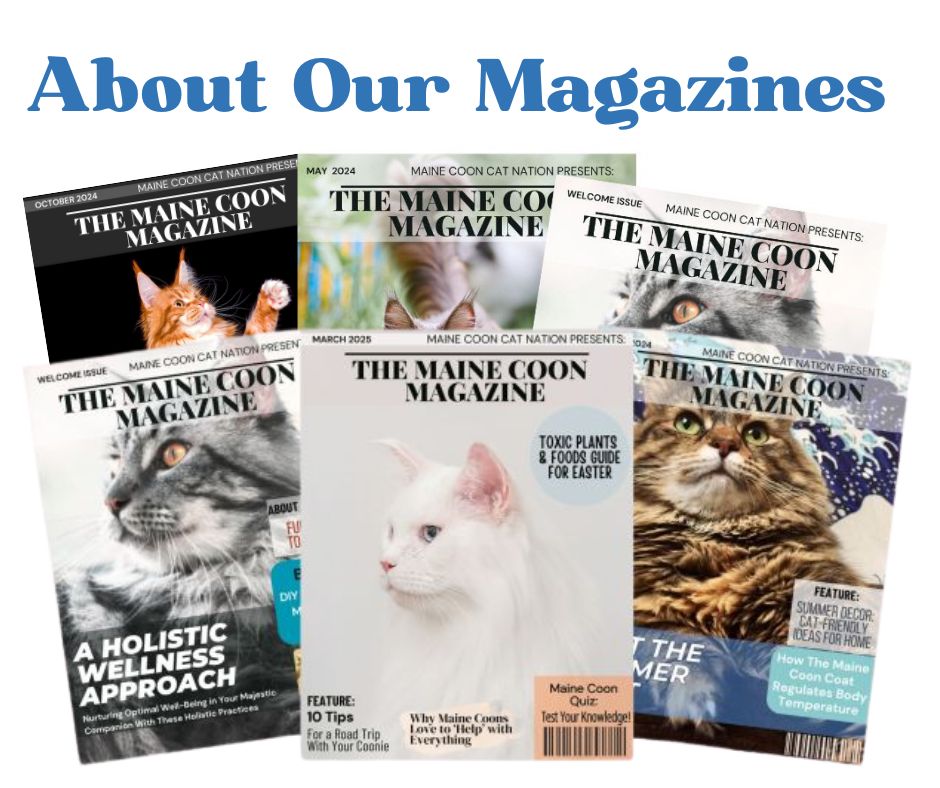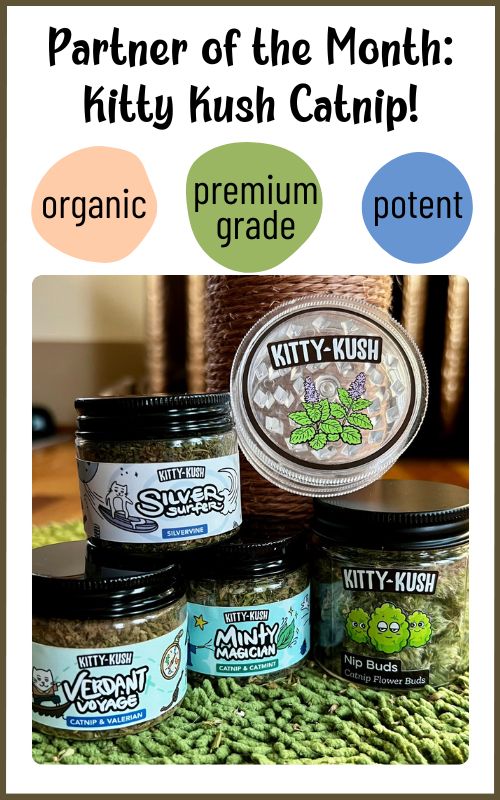- Home
- Maine Coon Grooming
- Cat Poop Stuck in Fur
Disclosure: this site is reader-supported. When you buy through links on our site, we may earn a small commission, at no extra cost to you.
Cat Poop Stuck in Fur
Keeping Your Feline Friend Fresh & Clean
by Carrie Profenno: Author, Coonie Mama & lifelong Mainer
... and The MCCN Community!
Maine Coons and other longhaired cats are prone to getting cat poop stuck in fur.
If you have a problem with dingleberries, dags, or fecal matting, try these reader suggestions!
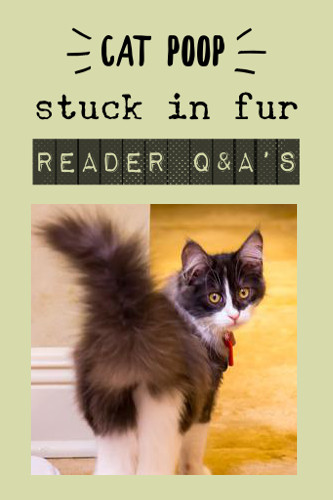 Pretty Azelin surely never has cat poop grooming problems!
Pretty Azelin surely never has cat poop grooming problems!Here are our reader questions and answers related to poop stuck in cat's fur.
Maine Coon cats (and some other breeds) are known for their glorious bloomers!
What an enchanting term for that fluffy fur around a cat's bottom and rear legs.
Sometimes, extra cat fur means the occasional grooming challenge back there.
It's "par for the course" when loving and
living with these very furry family members.
Or, are you dealing with poopy behavior issues?
Our community has been through it all.
Check out these related pages:
Maine Coon Grooming Tip:
One of the most useful grooming tips I wish someone had told me when Alice and Leo were young is keeping the fur around their rear trimmed.
It may sound simple, but it really makes a huge difference when it comes to litter box hygiene!
Back when Alice and Leo were kittens, I had to figure this out on my own. Their long, fluffy tails and rear fur were so adorable, but I quickly realized that things got messy around the litter box.
Trimming that area just a little bit keeps things cleaner and saves a lot of time cleaning up unexpected sticky "accidents."
Here’s how to do it:
- Use Pet-Safe Scissors: Choose a small, round-tipped pair of grooming scissors for safety.
- Trim Slowly: Carefully trim the fur around the rear and back legs, taking small snips to avoid any accidents.
- Keep It Regular: Check every couple of weeks and give it a touch-up when necessary.
This small grooming step is especially helpful for long-haired cats, as it reduces the chances of litter or waste getting stuck on the fur.
It makes a big difference in maintaining hygiene and keeping your cat more comfortable!
I only wish I had known this sooner - it could have saved a lot of trouble when Alice and Leo were young!
Poopy Problem
by: Deb in Port Leyden, New York, USA
We adopted a kitty from the local shelter. They said she had been tossed out of a car and the resulting broken back leg became infected and was removed.
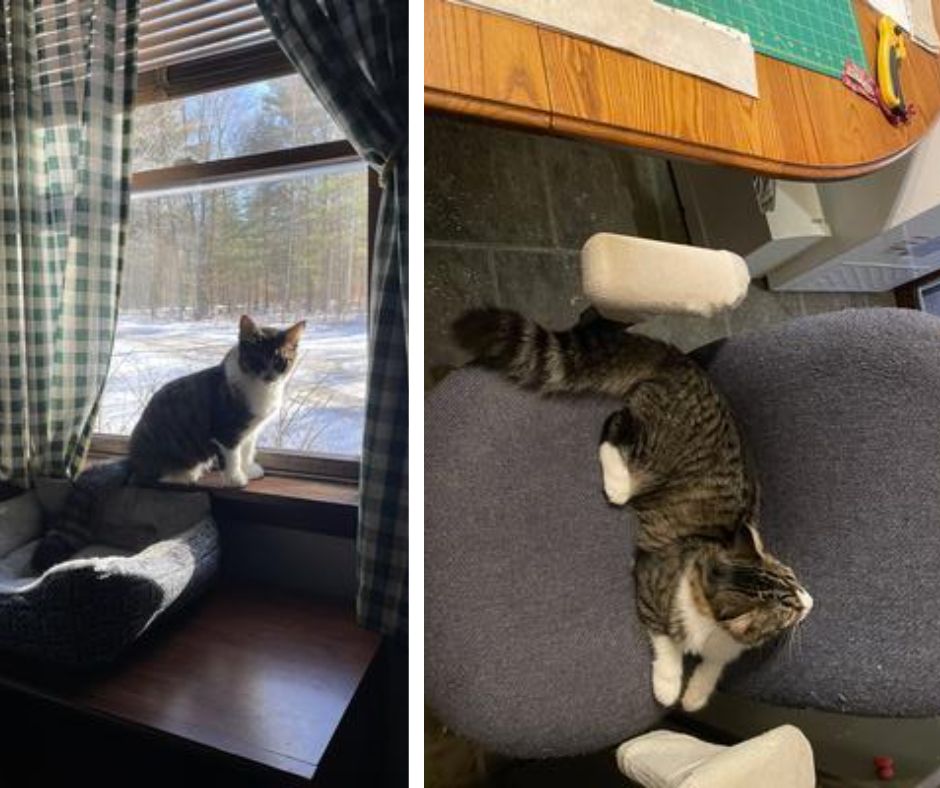
We pampered her and one day realized her “coon” tail, length of her body, ears, massive legs and her size matched Maine Coon cat descriptions. In fact she looks so much like photos of them I’d swear it was her.
The problem is the litter box- she is usually clean but once in a while she’s a mess. I looked through all the suggestions and like the bathtub cleaning method. She has razor blades for claws and she isn’t afraid to use them!
She is so precious- what an amazing kitty. I didn’t think about daily grooming- I’ll get on that today!! Adirondack Cat Mom.
Comments:
Baby Wipes
by: Vickie
Have you tried baby wipes? I have a cat that's a good 26 lbs or more and can't reach his backside to clean it. So I have started to use baby wipes to clean him off.
A Problem with Dingleberries...
By: Ann
(Washington State)
My medium/long haired Coon kitten (6 months old) is starting to
have periodic problems with "dingleberries."
She uses the litter box, and a while later, I find a pea-size
piece of fresh fecal matter within yards of the litter box.
She isn't pooping outside the litter box, but I
suspect her long fur is snagging things when she uses it.
I've heard of "sanitary shaving/trimming of longer haired cats' rear ends, but would like to hear the expertise of Maine Coon owners. Sorry for the graphic detail, but how else to describe...
Reply:
Hi Ann,
You are right, this is a fairly common problem. It happened to our Coonies more when they were kittens, and less often now.
Hopefully you will get some "fresh" ideas from other cat owners, but until then we have a few sections already where visitors have asked this question.
You can check the rest of this page to read my comments, and the experiences of others.
In my responses below, I go into detail with methods that have worked for us.
All The Best,
~Carrie
PS
Dingleberries is a great term to use for cat poop stuck in fur!
Getting My Dewey A Lion Cut?
by: Jenna
(Pensacola, FL)
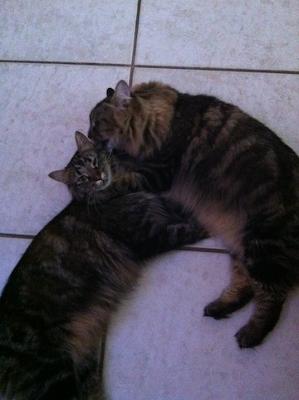 Dewey is having cat poop-in-the-fur grooming issues
Dewey is having cat poop-in-the-fur grooming issuesVanessa (left) Dewey (right)...
he can groom his sissy but not himself very well haha
I have 2 Maine Coons, Dewey and Vanessa. They are siblings, and of course they are my babies.
Vanessa has a lot better grooming habits than her brother and he
is starting to get a few small knots under his "armpits".
He also has some trouble with cat poop stuck in fur under his rear.
I groom him weekly, but I'm having the most trouble getting cat poop off around his butt...
I usually can snip off a few pieces of poop but I'm scared I might hurt him so I don't pursue the tougher ones... especially in such a sensitive area.
I'm wondering if anyone has any tips for this? I know if it gets too serious he will need to go to the vet to get the cat feces removed.
If I'm worried about anything with my babies they always go to a professional.
I'm also wondering if I should get him a lion cut. I think he would feel really good with one since he has a hard time cleaning himself.
However, I just wanted to know what other Coonies' owners think of getting their kitties the lion cut.
Reply:
Hi Jenna,
What a sweet picture, I love it :) This is a common issue with
long-haired felines. They are so pretty, but that fur in the rear can
pose an issue!
You might want to read the other, similar visitor questions and
comments on how they deal with cat poop stuck in fur.
As for the lion cut, I think that may be a good idea! I see that
you are in Florida, so Dewey and Vanessa live in a warm weather
climate.
We haven't tried the lion cut at our house. It's only hot
here for a short time, but I have been tempted to try it for Leo. He
gets knotted, too.
The lion cut would take care of Dewey's mats and stuck-on cat poops at the same time.
Some of the Maine Coon owners I've talked to
say their cat was a little "off" after the first one. Then
they got used to it and actually seemed to strut their stuff when
they got used to the lion cut.
Hopefully others will chime in on their experiences with both the
lion cut, handling mats, and getting rid of stuff stuck to the rear!
All The Best,
~Carrie
Comments:
Getting the rear clean
I have the same issues with mine also. I sit his rear in warm
soapy water, bathe him and then snip some fur away
if needed. He also gets a lot of cat litter stuck in his hind paws...
Have you tried a Furminator?
By: diva@great-womens-vacations.com
My sister is a vet (specializing in cats) and I have a geriatric Maine Coon with mats all over his fur. He never liked to be brushed (coons have sensitive skin and some don't like the pulling).
It's
much worse now, of course, since he's so arthritic he can't clean
himself well.
I use a FURminator (not sure of the spelling) and it does a wonderful job on the mats. It's a lot like brushing or combing, but there's a razor-like feature that helps to cut the fur under the mat or piece of poop, releasing it.
I've used this on mats that were pretty firmly stuck to his skin, without cutting or scratching him.
I'm
afraid of using scissors close to the skin; I accidentally knicked a
cat that way once. But the furminator gently and gradually works the
mat off.
I don't know about using it around the anal area, but it works great on the rest of his body, and he tolerates it pretty well.
Note: The following is an affiliate link, which means if you decide to buy something, I earn a small commission, at no extra cost to you. Rest assured I only recommend products that I would, or do use myself! >^..^<
There are quite a few different FURminators.
We use this one at home because it's for large, longhaired cats, but you can also see the full line of FURminators for cats & dogs for multiple pet households.
All that fur
By: Helen
My coon cat has a body coat that any show cat would be proud to sport. He is "bushy" with a lot of undercoat.
We both enjoy his daily grooming. When you do it every day you can catch the little knots before they get tight causing skin irritation, and it only takes a few minutes.
I live in Texas where the temperature has been over 100 degrees for over a month now. Today it was 107, a new record.
Despite the weather outside, he lives indoors where it is a cool 72 degrees. I would never think of cutting his hair.
The big fluffy hair is what makes my coon cat the envy of the neighborhood. I knew when I got him that daily grooming would be a part of owning such a magnificent animal.
Only a few times did The Bezzer Buzzer have diarrhea that stuck to his britches. I drew about three inches of lukewarm water in the tub, put a towel in the bottom, scruffed him by the neck and washed his bottom with my free hand.
I didn't use soap and I only washed the affected areas. He seemed to know I was helping him and didn't scratch or try hard to get away. (And a 21 pound cat can certainly go when he wants to!)
Keep your coon cat looking like a Coon Cat!
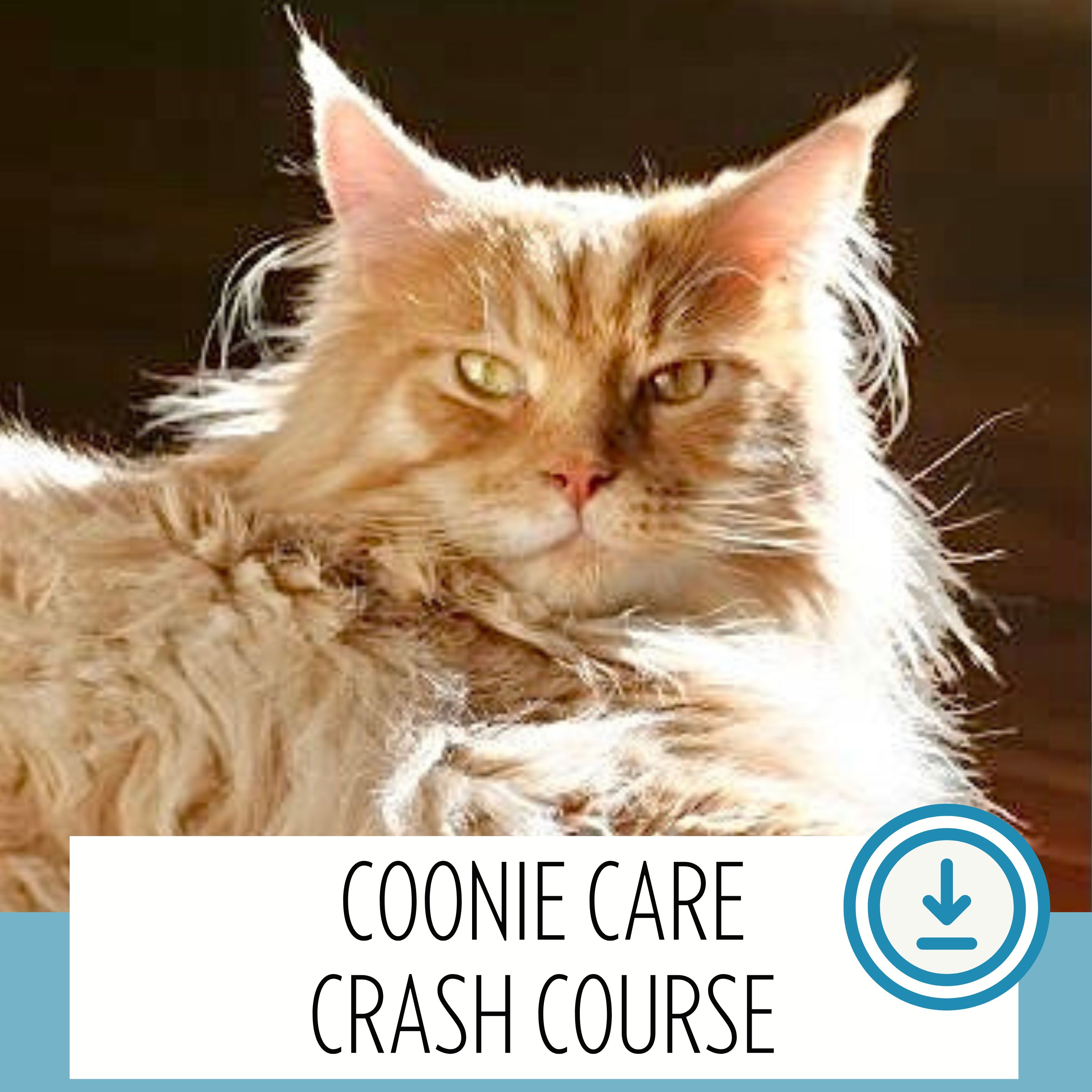
Maine Coon Dags?
Our 10 month old Maine Coon girl often has a problem with dags after a bowel movement.
I am wondering if this is a common thing if so is there any other
way of removing the poop bits than with scissors?
Reply:
Hi,
I must confess that I've never heard the word "dags!"
For others like me, here is a definition (the only one) I found on
the web:
"Dag is an Australian slang term, often used as an
affectionate insult for someone who is, or is perceived to be,
unfashionable, lacking self consciousness about their appearance
and/or with poor social skills yet affable and amusing."
Since this happens to your girl most often after she has been to
the bathroom, I'm guessing she has something hanging there that
shouldn't be?
It happens. At our house, we call these chunks of soft stool "hangers." And you are right, scissors will do the trick.
If one person holds her and the other snips the poop off, you'll be all set. It's
helpful to place a fine-tooth comb between the skin and the poo. For
us, it's the fastest and best way to keep them clean.
Interestingly, our cats mostly "grew out" of this as they became adults, by around 3 years old. I don't know why that is.
Maybe older cats are able to digest their food better, so the stools
become more dry?
I hope this helps. If your question was different, please post another comment here!
All The Best,
~Carrie
Comments:
"Dags"
By: Tallmama
Our 5 month old, Chief, has the same issue. Only he also gets the "stuff" well stuck into his paws!
It drives me crazy, as I then have to find a way to hold him still while I wash his paws (front and rear).
And he is already a strapping kitten weighing 9 pounds at 5 months! (Not fat at all!)
Anyhow, I have bought him the
largest litterbox imaginable, hoping that would help him not to step
in poop ... but he does it anyhow. Any suggestions?
Becca has the same problem
by: Katie
I have a Maine Coon female thats a little over a year old she has the same problem.
I think most long haired cats have the problem as well. I bought a pair of scissors to help with it. We didn't want to hurt her with the brush and comb.
To my surprise, she prefers that I brush them out. Same with the mats she gets in her mane. She keeps pulling on the brush while I brush her, and puts her head back for me to brush more until I get it out.
She's very laid back and mellow so
she just lies there or eats while I work them out. I do use scissors
for hanging pieces though.
Soft Feces Stuck to Fur
We feed our two 3 yr old spayed females Royal Canin dry food. Their stool has always been soft ("cow pie") but for the last year or so it has started sticking to the fur under the tail.
We comb the area every morning to remove the attached pieces of poop.
Often we find small blobs on the floor just outside their litter
boxes or elsewhere in the house. Trimming the fur in the area helps a
little but this is a tricky task. Is there a better diet which would
produce firm(er) feces?
They see our veterinarian regularly and are healthy and parasite
free.
Thanks!
Pat and Joanie
Reply:
Hi Pat and Joanie,
This is a common issue among long haired cats. We call them
"hangers" at our house.
I'm not sure that different cat foods would produce a "drier" stool. And, it wouldn't be healthy for them to have hard or dry stools.
Cat owners have different methods to deal with it, such as
trimming the fur or brushing & combing as you do.
As for the food, you might want to read our article on Royal Canin food & why we don't use it.
We have seen a
decrease in hangers since switching to a healthier, corn-free diet a
few years ago but I'm not sure if it was coincidence. We rarely deal
with it now. Perhaps they grew out of it.
Also, we had a similar question a little while back: Maine
Coon Dags. Other readers shared their tips & advice on
this page, which you might find helpful.
All The Best,
~Carrie
Comments:
Soft stools
by: Helen
I certainly would slowly introduce a different cat food. My vet recommends Pro-Plan. My breeder has used Science Diet for years.
We
have never had a problem with either brands. Your vet probably
carries Prescription Diet foods. Ask him if ID might be a good
choice.
Brushing Cat Bellies and Cat Poop Stuck in Fur
3yr old declawed Maine Coon rescue will not let me brush her belly and also get doo on her rear. How to deal with this?? Need grooming or sedation tips.
Reply:
Hi,
Some cats really don't like their bellies to be
touched, and it makes grooming that area really hard!
I would think sedation would be a last resort. If she has thick
mats and there is no other way, you can ask your vet about it.
First, you could try having someone help you. Maybe even two
people. One can hold her front paws, and one can hold her rear paws.
You have to use your good judgement on this, though. If my cat simply didn't like it, I would hold her down this way to get the job done.
If it turns into a situation where your kitty exhibits real
fear, panic, and starts thrashing, I would not put her through it.
In that case I would consider having a professional groomer shave
her belly and rear. This way no one has to touch it for a very long
time. This is assuming she has some real grooming needs down there.
A lot of cats can go for long periods of time without having a human groom them.
My Leo gets matted easily, but my Alice almost
never gets a mat- they have different fur types. So don't do it just
because you think you need to, only if there are mats and/or cat poop
stuck in fur.
Since your girl is declawed, that adds and extra element to it.
She's feeling very vulnerable and exposed. It's common for declawed
kitties to have some insecurities.
Other well-known tips involve wrapping kitty up in a towel, using
claw covers (for the rear claws if she still has them), wearing long
sleeves, kitty muzzles, etc.
It will be up to you as to what needs to be done and how far to go
before resorting to sedation. As for sedation tips, that would be a
question for your vet, as he/she would be the one doing it.
Hope this helps!
Carrie
Comments:
Cats with Mats
by: Pat in Florida
I just went through this with my one year old kitty, MiMi. She has never liked being brushed and had large mats under her hind legs and was starting to get them under the front legs.
I was not able to
remove them. I tried holding her down and using one of those mat
removers, and she would have no part of that! It was distressing.
I called my vet, as I trust her with my pets. I told her receptionist the problem and made an appt. for MiMi.
I was pretty
nervous when I took my girl in and left the exam room when it came
time for mat removal. I gave permission for sedation, if needed.
The vet's technicians removed those bad mats with no problem! One tech held the cat up and stretched out and the other one used a small shaver like men use to groom mustaches.
MiMi knew they were in charge
and complained, but did not struggle or fight them. She also let them
trim her nails!
I am SO relieved. I brush her a little each day and then give her
cat treats, but know I can take her back and not worry about it. It
was not expensive, either. I wish you the same good luck and
experience with your kitty.
Grooming
by: Helen
Sometimes if you scruff them up by the nape of their neck you can control the situation better.
This is how young kittens are carried
by their moms and they go limp when held this way. Some cats retain
this instinct into adulthood.
Declawed cats tend to bite in defense. Be careful.
Why does poop keep getting stuck in my
cat's fur?
Why does poop keep getting stuck in my cat's fur?
Cats are very clean animals, so it may come as a surprise to see poo stuck on their rear end. It can even happen to short-haired cats!
It's a good idea to rule out medical conditions or an underlying issue as possible causes at your next scheduled vet visit.
In most cases, this common grooming problem is simply a matter of soft feces sticking to the fluff on a cat's butt. It can happen even with a clean litter box and regardless of your cat's diet.
In addition to the methods mentioned above, you can use a paper towel to remove pieces of stool in cat's hair.
Baby wipes are handy for spot cleaning. A full bath shouldn't be needed.
Keep your cat's litter box as clean as possible of course, and when
it does happen, find a cleaning method that works for you both.
Cleaning cat poop stuck in fur is certainly not the most pleasant task a cat owner will have to deal with.
But with the help of a fine-toothed comb, some safety scissors and a bit of patience, your furry friend will be feeling - and smelling! - fresh again in no time.
Do You Have a Related Cat Question? Ask Us Here!
Do you have a question? Fill out the form below to get an answer! Give us as much information as you can, so we can best understand your unique cat questions!
Top of Cat Poop Stuck in Fur
« Back to Maine Coon Grooming
Recent Articles
-
Today's Features
Apr 16, 25 09:54 PM
Today we have two classic Memory Lane pages to share!
Murphy & Candy Cane: Double the Maine Coon Charm - This adorable Maine Coon duo from our 2011 Photo Albums - Murphy and Candy Cane - brought doubl… -
Memory Lane Month Begins!
Apr 15, 25 10:22 PM
We're thrilled to start our "Memory Lane Month" event by visiting some cherished moments from our community! We're in the process of restoring meaningful community stories like this one, to preserve t… -
Will a Maine Coon Protect Its Owner From Danger or an Intruder?
Apr 09, 25 10:41 PM
Plenty of people are curious: Will a Maine Coon protect its owner if something happens? Let’s talk about what this means, and what kind of protector a Coonie is.
